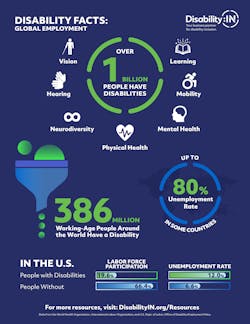Today, July 26, 2023, is National Disability Independence Day commemorating the passage of the Americans with Disabilities Act (ADA) signed into law on this day in 1990.
The U.S. Department of Labor states that “the Americans with Disabilities Act (ADA) prohibits discrimination against people with disabilities in several areas, including employment, transportation, public accommodations, communications and access to state and local government programs and services.”
Since its inception, the ADA has broken down barriers and improved the lives of thousands, if not millions, of people with disabilities. I am one of them. As a hard-of-hearing individual with profound deafness, the passage of the ADA back in 1990 ensured that I’d be able to successfully navigate and achieve a thriving career when I joined the workforce.
And as diversity, equity and inclusion efforts increasingly (and rightfully) take hold, many corporations are taking note, including those in the chemical industry.
For instance, several chemical companies have joined Disability:IN, a nonprofit organization supporting business disability inclusion worldwide. Its network of over 500 corporations helps expand opportunities for people with disabilities across enterprises.
The American Chemical Society has a Committee on Chemists with Disabilities designed to promote educational and professional opportunities in the chemical sciences and in fields requiring knowledge of chemistry for persons with disabilities.
The American Institute of Chemical Engineers (AIChE) also fosters inclusive communities through its Disabilities OutReach & Inclusion Community (DORIC). This active community includes workshops and webinars to improve inclusion communication and accessibility.
But the first step in any inclusion and accessibility efforts is for employees not to shy away from disabilities but understand and embrace them. In 2022, the U.S. Bureau of Labor Statistics reported 21% of employed workers are disabled, and that number is expected to grow.
This growth can be attributed to the ADA as well as advancements in technology. Remote connectivity and other technology-based assistive offerings have opened a number of doors and job openings for disabled workers. For example, FaceTime and Teams video calls have been game-changers for deaf individuals who rely on visual cues, lip reading or real-time closed captioning capabilities to ensure nothing gets lost in translation.
But technological advancements are only one piece of the puzzle to improving accessibility and inclusion. If you think back to schoolyard days, the simplest and easiest way to achieve inclusivity is by being kind and embracing others' differences.
As an employer or co-worker, how can you help those with disabilities at your site? Start by being welcoming. Learn about their background and challenges, be aware of how you can help increase awareness, and most importantly, make an effort to communicate – even if it’s in a different format than you’re used to. Such simple acts might make the difference in not only attracting but retaining those employees.
And, speaking of employee retention, if you haven’t yet taken our Job Satisfaction and Salary Survey, be sure to share your work experiences soon. The survey will close in August.
About the Author
Amanda Joshi
Managing Editor
Amanda Joshi has more than 18 years of experience in business-to-business publishing for both print and digital content. Before joining Chemical Processing, she worked with Manufacturing.net and Electrical Contracting Products. She’s a versatile, award-winning editor with experience in writing and editing technical content, executing marketing strategy, developing new products, attending industry events and developing customer relationships.
Amanda graduated from Northern Illinois University in 2001 with a B.A. in English and has been an English teacher. She lives in the Chicago suburbs with her husband and daughter, and their mini Aussiedoodle, Riley. In her rare spare time, she enjoys reading, tackling DIY projects, and horseback riding.


